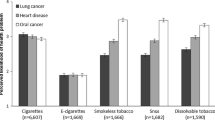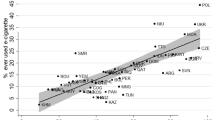Abstract
Dual use of conventional cigarettes and electronic cigarettes presents an emerging public health issue. Previous research has demonstrated a negative relationship between health literacy and conventional cigarette (CIG) use. However, the relationship between health literacy and e-cigarette (ECIG) use remains unclear. This studies examines the possible association of health literacy and CIG, ECIG, or dual use. A multinomial regression was used to model the association between health literacy and current CIG use, current ECIG use, or dual tobacco use status using state-optional data from the 2016 Behavioral Risk Factor Surveillance System (BRFSS; N = 40,404). One-third of the sample (N = 13,478; 33.3%) had initiated tobacco use. Approximately 36.6% of participants exclusively used cigarettes. A smaller proportion of participants were dual users of ECIG and CIGs (7.0%) and e-cigarette exclusive users (4.5%). After adjusting for covariates, higher levels of oral health literacy was associated with lower odds of current dual use. However, there was no significant association between written HL and either conventional cigarette use or electronic cigarette use or after adjusting for covariates. Oral messaging around the dangers of CIG use may be effective at lowering odds of CIG or dual use, especially for those with higher levels of HL. Further research is needed to examine how to best disseminate information regarding the health risks of ECIGs.

adapted from [34]

Similar content being viewed by others
References
Deniz, S. S., Özer, Ö., & Sonğur, C. (2018). Effect of health literacy on health perception: An application in individuals at age 65 and older. Social Work in Public Health, 33(2), 85–95.
Husson, O., Mols, F., Fransen, M. P., van de Poll-Franse, L. V., & Ezendam, N. P. M. (2015). Low subjective health literacy is associated with adverse health behaviors and worse health-related quality of life among cancer survivors: Results from the profiles. Psycho-Oncology, 24, 278–348.
Fernandez, D. M., Larson, J. L., & Zikmund-Fisher, B. J. (2016). Associations between health literacy and preventive health behaviors among older adults: Findings from the Health and Retirement Study. BMC Public Health, 19(16), 596.
Stewart, D. W., Cano, M. A., Correa-Fernández, V., Spear, C. A., Li, Y., Waters, A. J., Wetter, D. W., & Vidrine, J. I. (2014). Lower health literacy predicts smoking relapse among racially/ethnically diverse smokers with low socioeconomic status. BMC Public Health, 14, 7–16.
Stewart, D. W., Adams, C. E., Cano, M. A., Li, Y., Waters, A. J., Wetter, D. W., & Vidrine, J. I. (2013). Associations between health literacy and establish predictors of smoking cessation. Journal of Public Health, 103(7), e43–e49.
Nutbeam, D. (2000). Health literacy as a public health goal: A challenge for contemporary health education and communication strategies in the 21st century. Health Promotion International, 15(3), 259–267.
Chinn, D., & McCarthy, C. (2013). All aspects of Health Literacy Scale (AAHLS): Developing a tool to measure function, communicative, and critical health literacy in primary healthcare settings. Patient Education and Counseling, 90(2), 247–253.
Johnson, A., Sandford, J., & Tyndall, J. (2003). Written and oral information versus oral information only for patients being discharged from acute hospital settings to home. Cochrane Database of System Reviews. 4, CD003716.
Gibney, S., & Doyle, G. (2017). Self-rated health literacy is associated with exercise frequency among adults aged 50+ in Ireland. European Journal of Public Health, 27(4), 755–761.
Osborn, C. Y., Paasche-Orlow, M. K., Bailey, S. C., & Wolf, M. S. (2011). The mechanisms linking health literacy to behavior and health status. American Journal of Health Behaviors, 35(1), 118–128.
Dai, H., & Leventhal, A. M. (2019). Prevalence of e-cigarette use among adults in the United States 2014–2018. JAMA, 322(18), 1824. https://doi.org/10.1001/jama.2019.15331
Bao, W., Xu, G., Lu, J., Snetselaar, L. G., & Wallace, R. B. (2018). Changes in electronic cigarette use among adults in the United States, 2014–2016. JAMA, 319(19), 2039–2041.
Centers for Disease Control and Prevention (CDC). (2016). Behavioral Risk Factor Surveillance System Survey Data. Atlanta, GA: US Department of Health and Human Services, Centers for Disease Control and Prevention.
Pierannunzi, C., Hu, S.S., & Balluz, L. (2013). A systematic review of publications assessing reliability and validity of the Behavioral Risk Factor Surveillance System (BRFSS), 2004–2011. BMC Medical Research Methodology, 13(49).
Nelson, D. E., Powell-Griner, E., Town, M., & Kovar, M. G. (2003). A comparison of national estimates from the National Health Interview Survey and the Behavioral Risk Factor Surveillance System. American Journal of Public Health, 93(8), 1335–1341.
King, B. A., Dube, S. R., & Tynan, M. A. (2012). Current tobacco use among adults in the United States: Findings from the National Adult Tobacco Survey. American Journal of Public Health, 102(11), e93–e100.
American Lung Association. (2020). Cigarette smoking comparisons and disparities. Retrieved 17 Sept, 2020 from https://www.lung.org/research/trends-in-lung-disease/tobacco-trends-brief/cigarette-smoking-comparisons#smokingRatesByHealthInsurance.
Centers for Disease Control and Prevention (CDC). (2019b). Current cigarette smoking among adults in the United States. https://www.cdc.gov/tobacco/data_statistics/fact_sheets/adult_data/cig_smoking/index.htm. Accessed 24 March 2020.
Szklo, A. S., & Coutinho, E. S. F. (2009). Vulnerability and self-perceived health status among light and heavy smokers: The relationship to short-term fear appeal tobacco control messages. Cadenos de Saude Publica, 25(7), 1534–2152.
Jamal, A., Phillips, E., Gentzke, A. S., Homa, D. A., Babb, S. D., King, B. A., & Neff, L. J. (2018). Current cigarette smoking among adults—United States, 2016. Morbidity and Mortality Weekly Report, 67(2), 53–59.
Centers for Disease Control and Prevention (CDC). (2019a). Tobacco use by geographic region. https://www.cdc.gov/tobacco/disparities/geographic/index.htm. Accessed 24 March 2020.
Berkman, N. D., Sheridan, S. L., Donahue, K. E., Halpern, D. J., & Crotty, K. (2011). Low health literacy and health outcomes: An updated systematic review. Annals of Internal Medicine, 155, 91–107.
McCormack, L., Bann, C., Squiers, L., Berkman, N. D., Squire, C., Schillinger, D., Ohene-Frempong, J., & Hibbard, J. (2010). Measuring health literacy: A pilot study of a new skills-based instrument. Journal of Health Communication, 15(S2), 51–71.
Park, C. L., Cho, D., & Moore, P. J. (2018). How does education lead to healthier behaviors? Testing the mediational roles of perceived control, health literacy and social support. Psychological Health, 33(11), 1416–1429.
Ghosh, S., & Drummond, M. B. (2018). Electronic cigarettes as smoking cessation tool: Are we there? Current Opinions in Pulmonary Medicine, 23(2), 111–116.
Pepper, J. K., & Brewer, N. T. (2014). Electronic nicotine delivery system (electronic cigarette) awareness, use, reactions, and beliefs: A systematic review. Tobacco Control, 23(5), 375–384.
Cataldo, J. K., Peteresen, A. B., Hunter, M., Wang, J., & Sheon, N. (2015). E-cigarette marketing and older smokers: Road to renormalization. American Journal of Health Behavior, 39(3), 361–371.
Coleman, B., Rostron, B., Johnson, S. E., Persoskie, A., Pearson, J., Stanton, C., Choi, K., Anic, G., Goniewicz, M. L., Cummings, K. M., Kasza, K. A., Silveira, M. L., Delnevo, C., Niaura, R., Abrams, D. B., Kimmel, H. L., Borek, N., Compton, W. M., & Hyland, A. (2019). Transitions in electronic cigarette use among adults in the Population Assessment of Tobacco and Health (PATH) study, waves 1 and 2 (2013–2015). Tobacco Control, 28, 50–59.
Etter, J. F. (2010). Electronic cigarettes: A survey of users. BMC Public Health, 10(231), 1–7.
Wallston, K. A., Cawthon, C., McNaughton, C. D., Rotham, R. L., Osborn, C. Y., & Kripalani, S. (2014). Psychometric properties of the Brief Health Literacy Screen in clinical practice. Journal of General Internal Medicine, 29(1), 119–126.
Davis, T. C., Long, S. W., Jackson, R. H., Mayeaux, E. J., George, R. B., Murphy, P. W., & Crouch, M. A. (1993). Rapid estimate of adult literacy in medicine: A shortened screener. Family Medicine, 25(6), 391–395.
Benjamin, R. M. (2010). Improving health by improving health literacy. Public Health Reports, 125(6), 784–785.
McCarthy, K. (2017). Improving patient health literacy: Strategies for healthcare providers. https://nuemd.com/news/2017/05/29/improving-patient-health-literacy-strategies-healthcare-providers. Accessed 17 September 2020.
Nutbeam, D. (2008). The evolving concept of health literacy. Social Science and Medicine, 67, 2072–2078.
Author information
Authors and Affiliations
Corresponding author
Ethics declarations
Conflict of interest
The authors have no relevant financial or non-financial interests to disclose.
Additional information
Publisher's Note
Springer Nature remains neutral with regard to jurisdictional claims in published maps and institutional affiliations.
Rights and permissions
About this article
Cite this article
Clifford, J.S., Lu, J., Blondino, C.T. et al. The Association Between Health Literacy and Tobacco Use: Results from a Nationally Representative Survey. J Community Health 47, 63–70 (2022). https://doi.org/10.1007/s10900-021-01019-7
Accepted:
Published:
Issue Date:
DOI: https://doi.org/10.1007/s10900-021-01019-7




